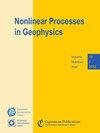Quantification of magnetosphere–ionosphere coupling timescales using mutual information: response of terrestrial radio emissions and ionospheric–magnetospheric currents
IF 1.7
4区 地球科学
Q3 GEOSCIENCES, MULTIDISCIPLINARY
引用次数: 0
Abstract
Abstract. Auroral kilometric radiation (AKR) is a terrestrial radio emission excited by the same accelerated electrons which excite auroral emissions. Although it is well correlated with auroral and geomagnetic activity, the coupling timescales between AKR and different magnetospheric or ionospheric regions have yet to be determined. Estimation of these coupling timescales is non-trivial as a result of complex, non-linear processes which rarely occur in isolation. In this study, the mutual information between AKR intensity and different geomagnetic indices is used to assess the correlation between variables. Indices are shifted to different temporal lags relative to AKR intensity, and the lag at which the variables have the most shared information is found. This lag is interpreted as the coupling timescale. The AKR source region receives the effects of a shared driver before the auroral ionosphere. Conversely, the polar ionosphere reacts to a shared driver before the AKR source region. Bow shock interplanetary magnetic field BZ is excited about 1 h before AKR enhancements. This work provides quantitatively determined temporal context to the coupling timelines at Earth. The results suggest that there is a sequence of excitation following the onset of a shared driver: first, the polar ionosphere feels the effects, followed by the AKR source region and then the auroral ionosphere.利用相互信息量化磁层-电离层耦合时标:地面无线电辐射和电离层-磁层电流的响应
摘要极光千米辐射(AKR)是由激发极光辐射的加速电子激发的一种地面无线电辐射。虽然极光千米辐射与极光和地磁活动密切相关,但极光千米辐射与不同磁层或电离层区域之间的耦合时标尚未确定。由于这些耦合时标是复杂的非线性过程,很少单独发生,因此估计这些耦合时标并非易事。本研究利用 AKR 强度和不同地磁指数之间的互信息来评估变量之间的相关性。相对于 AKR 强度,将指数移动到不同的时间滞后期,找出变量之间共享信息最多的滞后期。这个滞后期被解释为耦合时间尺度。AKR 源区先于极光电离层收到共享驱动因素的影响。相反,极地电离层先于极光电离层源区对共享驱动因素做出反应。弓形冲击行星际磁场 BZ 在 AKR 增强前约 1 小时被激发。这项工作为地球上的耦合时间线提供了定量确定的时间背景。结果表明,在共用驱动力开始后,会有一个激发序列:首先是极地电离层感受到影响,其次是 AKR 源区,然后是极光电离层。
本文章由计算机程序翻译,如有差异,请以英文原文为准。
求助全文
约1分钟内获得全文
求助全文
来源期刊

Nonlinear Processes in Geophysics
地学-地球化学与地球物理
CiteScore
4.00
自引率
0.00%
发文量
21
审稿时长
6-12 weeks
期刊介绍:
Nonlinear Processes in Geophysics (NPG) is an international, inter-/trans-disciplinary, non-profit journal devoted to breaking the deadlocks often faced by standard approaches in Earth and space sciences. It therefore solicits disruptive and innovative concepts and methodologies, as well as original applications of these to address the ubiquitous complexity in geoscience systems, and in interacting social and biological systems. Such systems are nonlinear, with responses strongly non-proportional to perturbations, and show an associated extreme variability across scales.
 求助内容:
求助内容: 应助结果提醒方式:
应助结果提醒方式:


